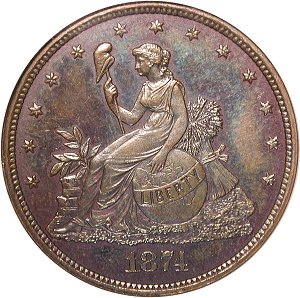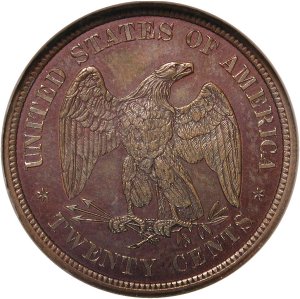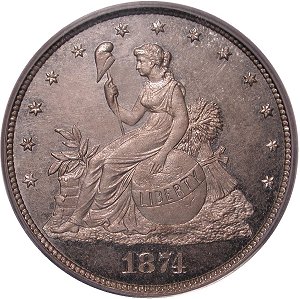2 Design Evolution - Patterns
Once it was clear that there was serious consideration of producing a new twenty-cent coin, it was time to begin investigating what type of design would be appropriate.
A number of patterns and trial strikes were produced in 1874 and 1875, demonstrating various options for the proposed coin. Four fundamentally different designs were
created. Three of these designs depicted different versions of a seated figure of Liberty – two slightly reminiscent of the obverse of the Trade dollar, and the other a
rendition of the Seated Liberty design present on the other silver coins of the day. The fourth design exhibits a Liberty Head concept.
The Participants
Henry Richard Linderman: Director of the Mint, 1867-1869, and appointed to the office again in 1873 when the Mint was moved to the Treasury Department and the Director’s office was moved to Washington. H. R. Linderman served as Mint Director again from 1873-1878.
James Pollock: Superintendent of the Philadelphia Mint, 1873-1879. Earlier in life, he served a term as Governor of Pennsylvania (1855-1858), and was later appointed Director of the Mint by President Lincoln in 1861, and reappointed by President Grant in 1869. He served in that role until becoming Superintendent in 1873.
William Barber: Chief Engraver of the Mint, 1869-1879. He was the designer of the Trade dollar and the twenty-cent piece, in addition to numerous patterns and medals. He succeeded James B. Longacre in the office upon Longacre’s death. Barber served as Chief Engraver until his death in 1879, and was later succeeded by his son, Charles E. Barber.
Joseph A. Bailly: Philadelphia sculptor, Assistant Engraver. He had also designed some interesting Trade dollar patterns in 1873.
1874
In the spring of 1874, Mint Director H.R. Linderman sent to Superintendent James Pollock a letter that resulted in the creation of the first patterns and experimental pieces produced for a United States silver twenty-cent piece.
April 20, 1874
To: James Pollock
Sir:
The issue of a 20 cent silver piece being under consideration, I have to request that you will cause a pair of experimental dies to be prepared for the same.
As the difference in weight between the proposed piece of 20 cents and the 25 cent piece will be quite small, it will be necessary to give to the former such devices etc., as will render it easily distinguished from the latter. I should therefore prefer the Bailey [sic] figure of “Liberty” as shown on one of the specimen Trade dollars and the Barber eagle as it appears on the Trade dollar. If reduced to the proper size I think they will be very appropriate.
This will afford a good opportunity for testing in a practical way some modifications which to possess considerable merit. In the first place let the dies be so made as to give the coin as much concavity on both sides as appears in the new 20 mark piece of Germany.
Secondly let us try the placing of one of the mottoes in lightly sunken letters around the periphery of the coin.
If the coin is properly concave on both sides and the border made sufficiently prominent, the chief devices will be so protected as to avoid abrasion in ordinary circulation.
It is better that any alteration of this character should be undertaken with the silver coin and not gold until thoroughly tested by actual coinage.
H. R. Linderman
Director
By summer, Pollock had delivered a number of pieces as requested by the Mint Director. The patterns used the Joseph A. Bailly motif from his 1873 Trade dollar pattern
on the obverse. Although Bailly produced the primary device design, it does not appear that he produced the entire obverse die. That task likely fell to Chief Engraver
William Barber, who also produced the reverse design. Barber used a scaled-down version of his eagle from the Trade dollar, now in its second year of production. This
reverse differs only in insignificant terms from the design that would ultimately be adopted the following year.
 |
 |
|
The Bailly-Barber design with eagle reverse |
Accompanying the pattern pieces, a letter from Pollack alerted Linderman that he had requested additional patterns be executed with a different reverse. A different reverse would make it easier to distinguish the twenty-cent piece from the quarter dollar. Pollack’s apparent concern was the similar size of the two denominations and that both would carry the image of an eagle, as required by law.
August 7, 1874
To: H. R. Linderman
Sir:
Enclosed find four specimen 20 cent pieces prepared as directed in one of your last letters. The design and execution are good but the coin too much like the quarter dollar in size and appearance. I have directed one or two other patterns to be prepared which will, I think remove some of the objections to the coins — be equally artistic and more easily distinguishable from the present quarter. The coins are to be distributed as follows, one to yourself, two for your cabinet, one for the secretary of the Treasury.
The price will be paid out of the fund still here for the purchase of coins as they having been ordered prior to June 30, 1874.
James Pollock
Apparently, Linderman thought the initial request, if executed properly, should have been enough to differentiate the twenty-cent coin from the quarter dollar, but was interested in seeing the second set of patterns, as evidenced by his letter sent the next day. It seemed that the similarity of size and weight might present a challenge after all.
August 8, 1874
To: James Pollock
Sir:
I have your favor of yesterday enclosing four specimen 20 cent pieces.
The design and execution are both excellent and it would appear that the devices and plain edge are sufficient to readily distinguish the pieces from the 25 cent coin. I would be glad to have the two pattern pieces which I understand are to be made so as to make a distinction between the 25 cent piece and 20 cent piece as clear as possible.
I suppose that the size of the 20 cent piece bears a true proportion to the 25 cent piece according to the weight of the two pieces respectfully, although have no means of comparing same.
H. R. Linderman
Director
The resulting second pattern design retained the Bailly obverse and provided a reverse consisting of the bold words 20 CENTS inside a laurel wreath. It was believed by Pollock
that a wreath and a large 20 would be more easily distinguished from the quarter, which had an eagle on the reverse.
 |
 |
|
Second Bailly-Barber design with reverse wreath |
1875
As the debate continued ...
